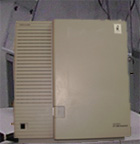Archival Notice
This is an archive page that is no longer being updated. It may contain outdated information and links may no longer function as originally intended.
Home | Glossary | Resources | Help | Contact Us | Course Map
ABI offered two gel-based real-time instruments, the ABI Prism® 373 and 377. In the mid to late 1990's, the ABI Prism® 377 DNA Sequencers were the most popular real-time instrument platforms for amplified DNA product separation. For the purpose of this discussion, the ABI Prism® 377 DNA Sequencers will be used, but it should be noted that both instrument platforms operate similarly.
The ABI Prism® 377 DNA Sequencers allow for simultaneous migration of amplified DNA products in different size ranges, which are multiplexed with different color fluorophores. The ABI Prism® 373 and 377 DNA Sequencers, as well as the ABI capillary electrophoresis instruments, allow for multi-component analysis, which is the process that separates the different fluorescent dye colors into distinct spectral components. The process of fluorescence detection is discussed in the next module.
Slab-gel electrophoresis methods provided the forensic community with a mechanism to separate and detect amplified DNA. Today, with the advances in technology and the need for increased automation, the majority of the forensic community has moved to the capillary-based systems. However, a few laboratories still use the ABI Prism® 377 DNA Sequencer or FMBIO®.
Capillary electrophoresis (CE) offers ease of use, high resolution, minimal sample consumption, speed, on-line detection, minimized cross-contamination concerns, and is fully automatable. Additionally, CE provides quantitative information. The next module will cover CE methods in detail.
Journals presenting different electrophoretic techniques:
- Analytica Chimica Acta
- Analytical Biochemistry
- Chromatographia
- Electrophoresis
- Journal of Chromatography A
- Journal of Chromatography B
- Journal of Pharmaceutical and Biomedical Analysis
- Journal of Proteome Research
- Journal of Separation Science
- Proteomics
Additional Online Courses
- What Every First Responding Officer Should Know About DNA Evidence
- Collecting DNA Evidence at Property Crime Scenes
- DNA – A Prosecutor’s Practice Notebook
- Crime Scene and DNA Basics
- Laboratory Safety Programs
- DNA Amplification
- Population Genetics and Statistics
- Non-STR DNA Markers: SNPs, Y-STRs, LCN and mtDNA
- Firearms Examiner Training
- Forensic DNA Education for Law Enforcement Decisionmakers
- What Every Investigator and Evidence Technician Should Know About DNA Evidence
- Principles of Forensic DNA for Officers of the Court
- Law 101: Legal Guide for the Forensic Expert
- Laboratory Orientation and Testing of Body Fluids and Tissues
- DNA Extraction and Quantitation
- STR Data Analysis and Interpretation
- Communication Skills, Report Writing, and Courtroom Testimony
- Español for Law Enforcement
- Amplified DNA Product Separation for Forensic Analysts


